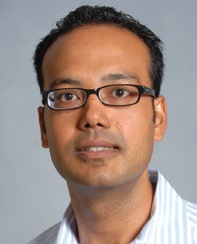Alberto Bilenca and Jeetain Mittal, two new professors in different engineering disciplines, converge in their interest in biological challenges.
Bilenca, assistant professor of electrical and computer engineering, works in biomedical photonics. He is studying imaging and sensing of the nanoworld in biocompatible settings, which could close the resolution gap between electron and conventional optical microscopy, and revolutionize the way we understand biology.
He works with ultrasensitive microscopy to target cavity-controlled light-based cytomics and proteomics. “This is a unique microscopy technology that is particularly important in cellular nanomechanics and single molecule experiments, where the detected optical signals are extremely low in power,” says Bilenca. “It also has the capacity to impact applications such as biomechanical imaging and lab-on-a-chip-based molecular recognition.”
Bilenca also uses light microscopy to quantitatively identify and classify tissue and biomaterials, which is essential to biomedical research. “I am investigating the use of optical coherent and scattering effects in disordered media to offer inexpensive, point-of-care technologies for tumor and blood disease diagnosis.”
Bilenca uses ultrasensitive microscopy to classify biomaterials.
Mittal is fascinated by the interior of a cell, which he says is a concentrated soup of several macromolecules. “I focus on macromolecular crowding effects, where the cell constituents not actively participating in a given reaction under study are labeled as part of the crowd.” He notes that the presence of a large number of macromolecules will change the behavior of the most important constituent in the cell – water – which modulates reactions in the cell.
He uses a “divide and conquer approach” to understand macromolecular crowding effects. “We construct theoretical models with different degrees of complexity. For example, we will build models that separate the direct effect of crowding from the indirect effect through hydrophobic interactions in order to break the problem into manageable subsets.”
Advanced computational methods generate data on long-time behavior, Mittal says, which can be used to predict the collective behavior arising from various effects closely resembling the interior of a cell. This will help extend the findings from commonly performed dilute solution experiments to solution conditions resembling intracellular environment.


